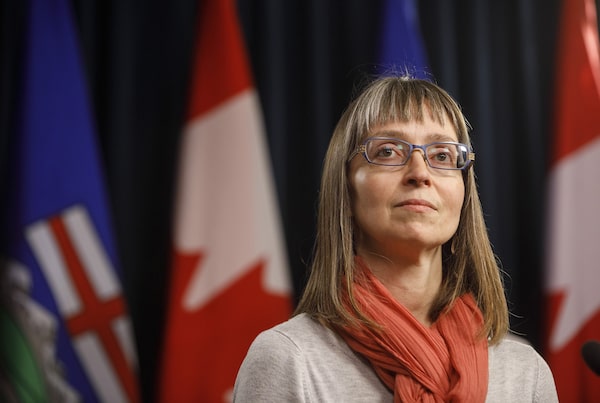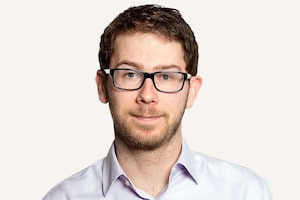
Alberta chief medical officer of health Dr. Deena Hinshaw says the move to lift COVID-19 public-health measures is based on the effectiveness and volume of vaccines.JASON FRANSON/The Canadian Press
Alberta’s plan to lift almost all COVID-19 public-health measures by mid-August is being decried by medical experts and has left cities, schools and businesses wondering what to do to guard against the virus.
Officials announced this week that the province will end routine contact tracing outside of high-risk settings and no longer require those who do test positive to isolate, among other protocols.
While local governments and businesses can continue to implement measures such as mask mandates after Aug. 16, they cannot do widespread testing and tracing, or require people to isolate, leaving them with few tools to meaningfully respond to a continuing pandemic.
Stephanie Smith, an infectious-disease physician at the University of Alberta Hospital, said there remains a large population of unvaccinated children who are not immune to COVID-19 and that they will be put together in confined spaces in schools come September.
“I think that we’ve worked so hard, and people have made so many sacrifices,” Dr. Smith said. “I can certainly appreciate that people want to just go back to normal, but I think doing it too early when … we’re in a bit of an uncertain situation may backfire.”
Joe Vipond, an emergency-room physician in Calgary, said he was “outraged” to learn of Alberta’s plan, calling it an “incredibly risky policy” that will cause harm.
“Let’s not pretend that what they’ve done is just a shrug of the shoulders and we’re moving on,” Dr. Vipond said. “These are decisions, these are policies, there are human beings making these decisions to imperil other human beings. … Suddenly, the enemy’s not the virus; the enemy’s the government.”
Dr. Vipond said there are still numerous risks and uncertainties, including COVID-19 breakthrough rates, long-term disability and the impact on children. He called on Albertans to act to ensure that these changes do not happen.
Deborah Yedlin, president and chief executive of the Calgary Chamber of Commerce, said she heard that businesses are surprised by the move and plan to uphold some public-health measures throughout the summer and beyond.
“The sense that I got is that … businesses are going to continue to do what they need to do to keep employees, customers, clients and guests safe,” she said. “To be associated with any sort of outbreak means your reputation is compromised [and] nobody wants to do that.”
But the result may be a patchwork approach, with people not knowing what to expect across businesses, she said.
Annie Dormuth, Alberta’s director of provincial affairs for the Canadian Federation of Independent Business, said roughly half of business owners in the province are still upholding some COVID-19 safety measures while the other half has lifted all restrictions. She said Alberta lifting its isolation requirement could prompt some businesses to re-evaluate their plans.
“As of right now, we haven’t really heard any concerns from our members about it, but I do anticipate as this rolls through past August 16 that we probably will,” she said.
Jonathan Teghtmeyer, spokesman for the Alberta Teachers’ Association, said the news is “troubling” for members. Doing away with routine testing and tracing means that it’s possible neither students nor their families will know if they contract COVID-19, and it will be difficult for schools to know the extent to which the virus is spreading through classrooms, he said.
Masking will no longer be required when students return to school but will be “recommended” in the event of outbreaks.
“The government seems to be taking the approach that because the outcomes of children and COVID are less severe, that they don’t mind if it happens to spread rapidly in schools,” Mr. Teghtmeyer said.
While schools could potentially create their own policies, he said they could face backlash for going beyond government guidelines.
“I just think it’s irresponsible at this point to get rid of these very basic measures which do not pose a significant intrusion and would really go a long way to ensure that COVID is kept under control,” Mr. Teghtmeyer said.
Edmonton Mayor Don Iveson said he was surprised by the province’s decision and that council will discuss the city’s response at its next emergency advisory committee meeting scheduled for Aug. 12.
Calgary Mayor Naheed Nenshi called the province’s move “the height of insanity” and said if he were in another jurisdiction, he would be considering putting travel restrictions on Albertans when public-health measures are lifted.
On the same day as Alberta’s announcement, an outbreak was declared in B.C.’s Central Okanagan region and measures including mandatory masking in indoor public places reintroduced. Asked about visiting Albertans, Provincial Health Officer Bonnie Henry said B.C. won’t likely turn people away.
“We’re happy to have you come fully vaccinated, and when you’re here, we expect that everybody takes the measures that we are continuing to take in B.C. to protect people,” she said Thursday.
Asked about Alberta’s plan, Ontario Solicitor-General Sylvia Jones said her province was sticking with its mask rules as more indoor activities open up. She noted that Israel and Britain have had to reimpose rules they had lifted as cases started climbing.
“We are going to continue with the pathway that keeps the vast majority of Ontario citizens safe,” Ms. Jones said.
On Thursday, Alberta Health Minister Tyler Shandro defended the changes, which he said were driven by Chief Medical Officer of Health Deena Hinshaw and her team. He insisted that the new policies are based on science and data, and said he expects other provinces to follow suit.
In an interview, Dr. Hinshaw said it’s understandable that people need some time to process these changes.
“We have been approaching COVID in a very specific way for 17 months. The shift we’re making is a large shift.”
But Dr. Hinshaw said the swiftness of the change is predicated on the effectiveness and volume of vaccines.
“COVID-19 pre-vaccine was a disease that could easily have overwhelmed the health care system, and required extraordinary interventions. COVID-19 with highly effective and broadly available vaccines is still problematic. And absolutely can still cause problems for people, especially those who are not immunized.”
But “the reality is, our risk has dramatically changed in the last few months.”
Alberta had by far the highest per-capita rates of COVID-19 infections in Canada during the second and third waves, including a period in May when the province had the highest rates of new infections anywhere in North America. Alberta also led the country for hospital and ICU admissions late last year.
The province once again has among the highest infection rates in the country, behind only Yukon and Saskatchewan. However, Dr. Hinshaw and Premier Jason Kenney have urged the public not to put so much emphasis on daily case counts, arguing that the success of vaccines means that they’re no longer a predictor of severe outcomes that could overwhelm the health care system.
Alberta added 233 new infections on Thursday, the highest daily total since early June, as infections have more than doubled in less than a week.
With reports from Jeff Gray and Kelly Cryderman
We have a weekly Western Canada newsletter written by our B.C. and Alberta bureau chiefs, providing a comprehensive package of the news you need to know about the region and its place in the issues facing Canada. Sign up today.
 Andrea Woo
Andrea Woo James Keller
James Keller